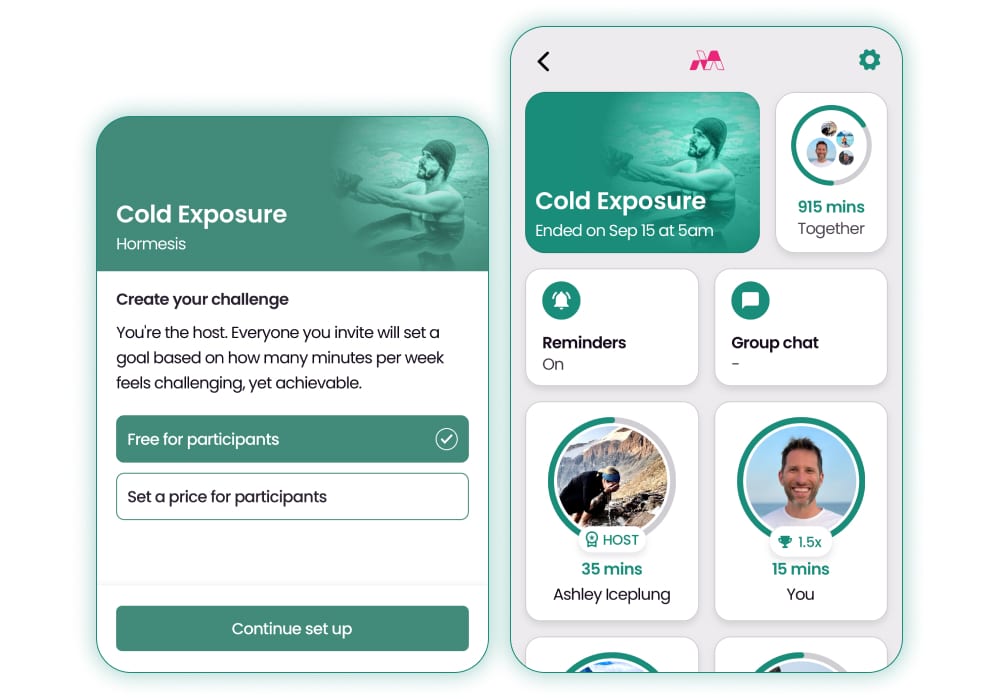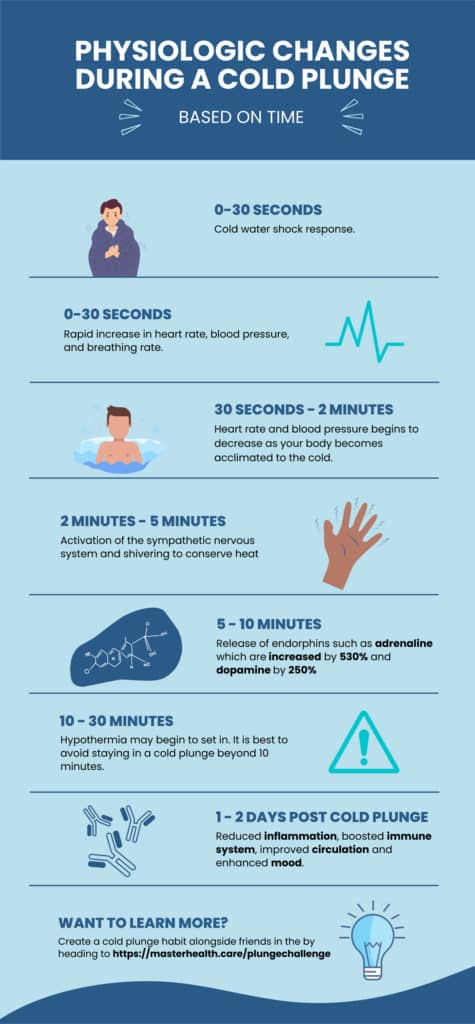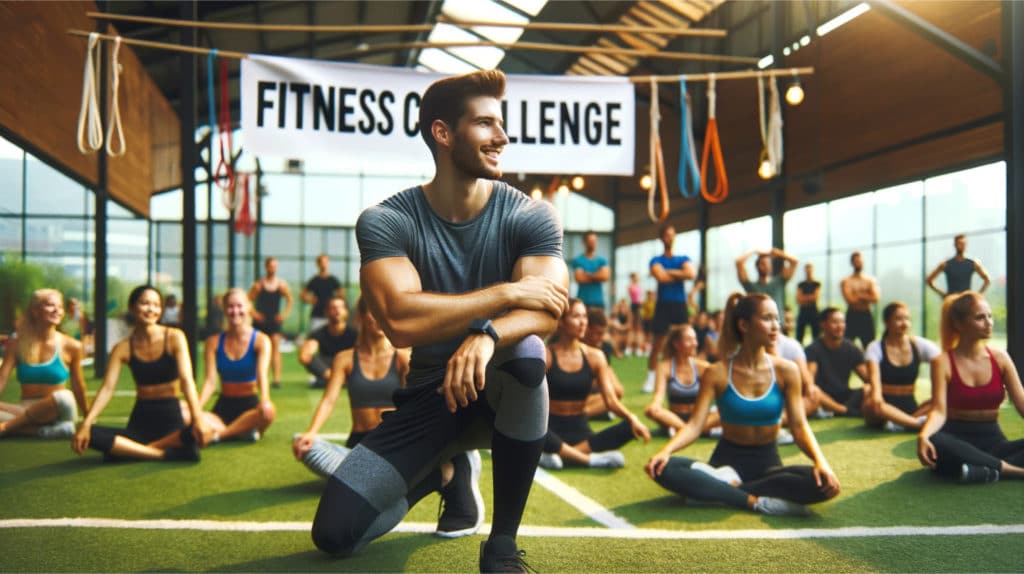

Start a cold plunge challenge with your group and have fun getting healthier together.
INTRO
What is a Cold Plunge?

A cold plunge involves immersing the body in cold water and exposing the for health and wellness benefits. Cold exposure isn’t limited to cold plunges, however, and can be done in a variety of ways, such as taking cold showers or spending time in cold environments.
Cold exposure is believed to have a number of potential health benefits, including improved circulation, increased immune function, and reduced inflammation. It may also help to improve mood and reduce stress.
Starting a cold plunge challenge is a fun and fantastic way to involve someone else who might like to build a cold exposure habit with you.
Cold Plunge Benefits
There are many potential health benefits to cold plunging, whether in ice baths, a cold shower, or other environments:
1. Improved circulation
Cold exposure can help to improve circulation by constricting blood vessels and then dilating them as the body warms up. This can help to deliver oxygen and nutrients to the cells more efficiently.
2. Increased immune function
Cold exposure may help to stimulate the immune system, potentially increasing the production of white blood cells and antibodies.
3. Reduced inflammation
Cold exposure may have anti-inflammatory effects, helping to reduce inflammation in the body.
4. Improved mood and stress reduction
5. Increased fat burn
Cold exposure may increase the production of brown fat, a type of fat that is thought to help burn calories. In addition, men who practice regular cold plunges (1x/week) and cold showers (5 days/week) were found to have significant fat loss
It’s important to be cautious when engaging in an ice bath challenge or other cold exposures, as it can be physically demanding and may not be suitable for everyone. It’s always a good idea to consult with a healthcare professional before starting out.
How to do a Cold Plunge Challenge

The anticipation before starting a cold plunge can be both exciting and intimidating.
Here are some important components to consider so that you have more fun and less fear!
Safety: Cold exposure can be physically demanding and may not be suitable for everyone. It is important to be cautious and to start slowly, particularly if you have a medical condition or are not in good physical shape.
Gradual exposure: It is generally recommended to start with short periods of cold exposure and gradually increase the duration and intensity over time. This can help your body acclimate to the cold and reduce the risk of injury.
Warm-up and cool-down: It is important to warm up and cool down properly and naturally before and after cold exposure.
This can help to reduce the risk of injury and make the experience more comfortable. Try to allow your body to warm up naturally after finishing with your cold exposure challenge.
Frequency and duration: The frequency and duration of cold exposure will depend on your goals and your comfort level.
It’s generally recommended to start with short periods of cold exposure and gradually increase the duration over time.
Hydration: It is important to stay hydrated during and after cold exposure, as the body can lose fluids through your respiration and other processes.
4 Key Variations of Cold Exposure
There are many different ways to benefit from cold exposure practice. Regardless of the specific method being used, it is important to be cautious and to start slowly when engaging in cold exposure.
Some of the most common approaches include:
1. Cold immersion
This involves immersing the body in cold water, such as in a lake, river, ocean, or bathtub. You may choose to do this in a wet suit or other protective clothing.
2. Cold showers
Taking a cold shower involves standing under cold water for a period of time. This can be done all at once or gradually, starting with warm water and gradually decreasing the temperature.
3. Cold environment exposure
This involves spending time in a cold environment, such as going for a walk or jog in cold weather or spending time in a cold room
4. Cold therapy
Cold therapy, also known as cryotherapy, involves exposing the body to very cold temperatures, typically in a specially designed chamber or with the use of ice packs.

Building a Cold Exposure Habit
1
Start small
If you’re new to cold exposure, start with short, easy exposures and gradually increase the duration and intensity over time.
2
Make it convenient
Choose a method of cold exposure that is convenient and easy to fit into your daily routine. For example, you might try taking a cold shower in the morning or spending a few minutes in a cold room before bed.
3
Find activities you enjoy
Choose a method of cold exposure that you find enjoyable and that fits your personal interests. This will make it more likely that you will stick with the habit.
4
Track your progress
Keep a record of your cold exposure, and celebrate small wins and improvements along the way. This can help to keep you motivated and engaged.
5
Get support
Invite a friend or family member to join you in your ice bath challenge. This way you can encourage and hold each other accountable to keep up the cold exposure habit. Alternatively, you can join a class or hire a personal trainer to provide guidance and support.
Try to engage in cold exposure regularly, at least a few times a week. Consistency is key to building any habit, so make sure to set aside time for cold exposure on a regular basis.
6
Be consistent
Try to engage in cold exposure regularly, at least a few times a week. Consistency is key to building any habit, so make sure to set aside time for cold exposure on a regular basis.

Build a Cold Plunge Habit
Start a cold plunge challenge with your community, clients or friends and have fun getting healthier together.

Start a cold plunge challenge with your community, clients or friends and have fun getting healthier together.
Ice Bath Setbacks

Cold water exposure can be tough! But having the right mindset and game plan can help keep you motivated to continue.
Take it slow: If you’re having difficulty adjusting to the cold, try starting with short, easy exposures and gradually increasing the duration and intensity over time. This can help your body acclimate to the cold and reduce the risk of injury.
Find activities you enjoy: Choose a method of cold exposure that you find enjoyable and that fits your personal interests. This can help to keep you motivated and engaged.
Make it convenient: Choose a method of cold exposure that is convenient and easy to fit into your daily routine. This can help to overcome time constraints and make it more likely that you will stick with the habit.
Get support: Enlist the help of a friend or family member to hold you accountable and encourage you to keep exposing yourself to the cold. Alternatively, you can join a class or hire a personal trainer to provide guidance and support.
Focus on the benefits: Remind yourself of the potential health benefits of cold exposure and stay positive and motivated and focus on the great feeling you get from the flood of endorphins.
Ice Bath FAQ’s
Initially, the body responds with a shock response, evident by gasping and increased heart rate, as it reacts to the cold. This reaction, however, begins to moderate within the first minute.
By the 2-minute mark, the body starts adapting, evidenced by a slowing heart rate and deeper, more controlled breathing.
At different water temperatures, the cold plunge benefits vary.
At 40 degrees Fahrenheit, the body experiences a significant shock response, potentially maximizing adrenaline release and boosting endorphins.
At 55 degrees, the response is less intense, but still significant, promoting circulation and reducing inflammation.
A 65-degree plunge provides a milder yet still effective experience, suitable for those new to cold exposure.
This 2-minute duration is critical in ensuring these cold plunge benefits are reaped safely, avoiding risks like hypothermia and allowing the body to adapt without undue stress.
Physiological Response to Extreme Cold (at or below 0 degrees Celsius / 32 degrees Fahrenheit)
- Vascular and Cardiovascular Response: Immersion in ice water induces a more intense vasoconstriction compared to milder cold water. This rapid constriction of blood vessels helps to preserve core body temperature but places significant stress on the cardiovascular system. The heart rate initially spikes, followed by a rapid decrease, which can be risky for individuals with underlying heart conditions.
- Metabolic Rate: The body’s metabolic rate increases substantially in response to extreme cold as it works to generate heat internally. This elevated metabolic activity can lead to higher calorie burn but also puts considerable strain on the body’s energy systems.
- Pain and Nerve Sensitivity: At freezing temperatures, the nerve endings in the skin can transmit strong pain signals, which might be overwhelming for unacclimated individuals. This can potentially lead to shock or fainting.
- Gradual Vascular Response: Plunges in water above freezing induce vasoconstriction more gradually. The cardiovascular system is less shocked, making it safer for a broader range of individuals, including those with certain health conditions.
- Moderate Increase in Metabolic Rate: The metabolic rate increases, but not as drastically as in freezing temperatures. This makes the practice more sustainable and less taxing over longer periods.
- Reduced Pain and Nerve Sensitivity: The nerve response to mild cold is less intense, reducing the risk of shock and allowing for a more prolonged exposure, which can be beneficial for therapeutic purposes like reducing inflammation and improving muscle recovery.
However, delving into colder territories, specifically temperatures below 10 degrees Celsius, introduces a more extreme form of therapy. Such frigid waters trigger a pronounced shock response, characterized by the activation of the sympathetic nervous system and a subsequent adrenaline surge. This acute physiological reaction can enhance alertness and impart a sense of invigoration. Due to the intensity of these effects, immersions at these lower temperatures are generally kept brief and are recommended for shorter durations to ensure safety and manage the body’s stress response effectively.
The duration of immersion in cold water is equally critical in shaping the therapeutic experience. Short-duration immersions, typically lasting between 1 to 5 minutes, are favored in therapeutic settings for their efficiency in reducing muscle soreness and inflammation, without imposing undue stress on the cardiovascular system. In contrast, prolonged immersions extending beyond 5 minutes can pose risks, particularly at lower temperatures, where the likelihood of hypothermia escalates.
Yes, there are certain health conditions which cold exposure is contraindicated or may be harmful for. These include:
Raynaud’s disease: Cold exposure can cause vasospasms, worsening symptoms for people living with Raynaud’s disease.
Cold urticaria: This is a condition where skin breaks out in hives when exposed to cold temperatures, and can be life-threatening in severe cases.
Hypothyroidism: Cold exposure can cause a decrease in thyroid function in individuals with hypothyroidism, potentially leading to symptoms such as fatigue, weight gain, and depression.
Hypothermia: If your body is unable to maintain a core temperature of around 98.6°F, you may be at risk for hypothermia, which can be life-threatening.
Cardiovascular disease: Cold exposure can cause an increase in heart rate and blood pressure, which can be dangerous for individuals with cardiovascular disease.
Immune-compromised individuals: Cold exposure can place additional stress on the immune system, which can be harmful for individuals who are already immunocompromised.
Rheumatoid arthritis: It’s advised that people living with rheumatoid arthritis avoid or minimize their cold exposure, since the cold can increase aches and pains.
As ways, speak to a medical professional first to check if an ice bath challenge would be safe for you to try.
If you find it difficult to tolerate cold temperatures, there are alternative methods of practicing cold exposure that may be more manageable for you. One option is to decrease the temperature gradually to build up a tolerance for cold, or you can try alternating hot and cold showers to build up a tolerance, always finishing with cold water.
Alternating hot and cold showers is a technique that can stimulate blood flow, boost immunity, and improve overall health and wellness. Here’s how to do it:
- Start with a warm shower: Begin by taking a warm shower for 2-3 minutes to relax your muscles and open up your pores.
- Switch to cold water: After 2-3 minutes, switch to cold water for 30-60 seconds. The water should be as cold as you can tolerate.
- Repeat the process: Alternate between warm and cold water for 2-3 cycles. Start with 30-60 seconds of cold water, followed by 2-3 minutes of warm water.
- Finish with cold water: End the shower with 30-60 seconds of cold water to close your pores and increase alertness.
It’s important to listen to your body and to stop the exposure if you feel discomfort or experience any adverse effects. It’s best to start with shorter exposure times (30 seconds of cold water) and gradually increase the duration as your body becomes more adapted to the cold.
Support for Your Ice Bath Challenge
When you’re just starting out with any new habit, it helps to have a solid foundation for resources and support to help you stick to your routine. An ice bath challenge is no exception. Here are a few resources that can support your new habit.
Find a buddy: Find someone who is also interested in starting an ice bath challenge and practice together for added motivation and accountability.
Keep track of progress: Keep a journal or log of your cold exposure sessions to track progress and measure the benefits you experience. Consider using a thermometer to measure the temperature of the water at each cold plunge!
Find a support group: There are several online communities and forums where people interested in cold exposure can connect and share tips and experiences.
Seek professional guidance: Consider working with a coach or therapist who has experience with cold exposure to get personalized support and guidance.
Use tools and resources: There are several resources available, such as books, articles, and videos, that can provide information and guidance on cold exposure practice.
Purchase an ice bath: If you’re finding that the cold water from your tap isn’t cold enough, consider investing in a portable ice bathtub.











